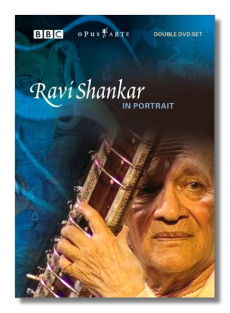
The Internet's Premier Classical Music Source
Related Links
- Latest Reviews
- More Reviews
-
By Composer
-
Collections
DVD & Blu-ray
Books
Concert Reviews
Articles/Interviews
Software
Audio
Search Amazon
Recommended Links
Site News
 DVD Review
DVD Review
Ravi Shankar

In Portrait
- Disc 1: Between Two Worlds
- Disc 2: Live in Concert:
- Raga Anandi Kalyan
- Raga Rangeela Piloo
BBC Opus Arte OA0864D 2DVDs 190min
More than just an Indian musician, Ravi Shankar is a musician of the world. Only the late Yehudi Menuhin (coincidentally, Shankar's sometime collaborator) saw the global implications of musical expression this clearly and conveyed them this convincingly. Like Menuhin, Shankar's spirituality and musicianship have become more transcendent as his 80th birthday has come and gone, and these DVDs are a moving portrait of a man who almost becomes a saint when he plays.
Between Two Worlds is an atmospheric documentary that looks back on Shankar's life on the occasion of his 80th birthday and the construction of the Ravi Shankar Foundation complex in New Delhi. In his youth, he was part of his brother Uday's touring dance company, but instead of being seduced by the high life in cities like Paris and New York, Shankar went to study with Ustad Allauddin Khan, a guru for whom Shankar still has the utmost reverence. The film recounts Shankar's work with Indian filmmaker Satyajit Ray, and how he was embraced by the youth culture, an embrace from which Shankar eventually recoiled. Shankar's life intersected with the lives of musicians as diverse as Menuhin, John Coltrane, and Beatle George Harrison, and archival footage from the 1960s will bring back many memories for viewers of a certain age. Throughout, the filmmakers have complemented Shankar's story with images of birth, life, and death along the Ganges in Benares (Varanasi), the city in which Shankar was born. The documentary ends with a joyous excerpt from a recent concert in San Diego. As they play Raga Mishra Piloo, Shankar's daughter Anoushka, who also plays sitar, watches her father with a mixture of astonishment and adoration – emotions that we ourselves must feel when we are confronted by Shankar's musicianship, his humility, and most of all, his humanity.
The bonus on Disc 1 is a 19-minute segment in which Shankar teaches Anoushka and other musicians a new piece, Benares Ghat. Shankar, rather than writing a score out in isolation, prefers to work it out in the presence of the musicians, and it is interesting to see the process being carried out here.
Disc 2 contains footage from a 2002 concert, held in London's Union Chapel. Raga Anandi Kalyan lasts for 30 minutes, and Raga Rangeela Piloo for almost 24, so here's an excellent opportunity to enjoy Shankar at his most pure and expansive – and with undiminished powers. Again, he is joined by Anoushka. The other musicians are Bikram Ghosh and Tanmoy Bose, who both play tabla. The camera dotes on Shankar's face as much as Anoushka does, but apart from that, this is as close to a real Shankar concert as most of us will ever get.
The bonus on Disc 2 is Shankar's 19-minute lecture about the sitar and the fundamentals of Indian music. I'm afraid even a simplistic explanation of Indian music is impossible in so short a time, but while this documentary gives only the most rudimentary introduction, it is nice to spend this intimate time with the master.
The production values on these DVDs are very high; the sound in particular is some of the finest I've heard from the medium. The video images are crystal clear.
God bless Ravi Shankar – may he play for another 80 years! And thank you Opus Arte for releasing these DVDs to the public.
Copyright © 2007, Raymond Tuttle




















